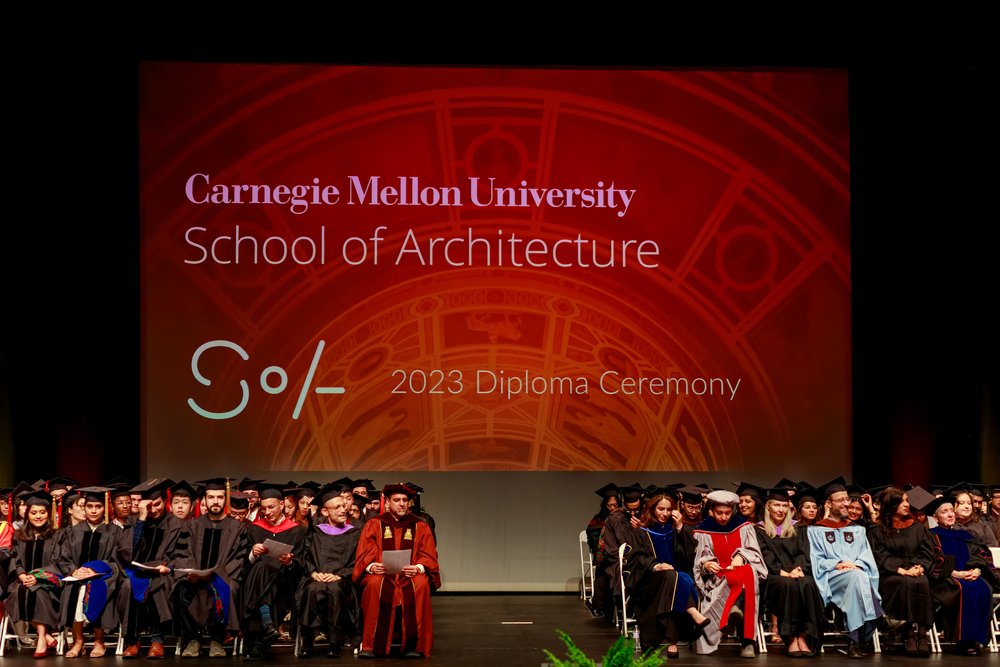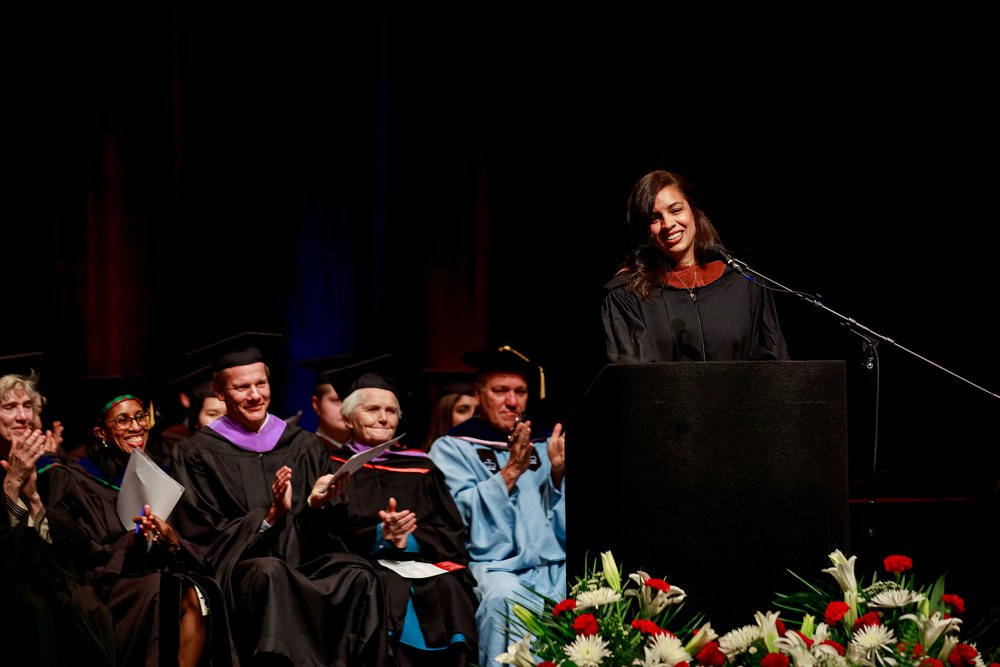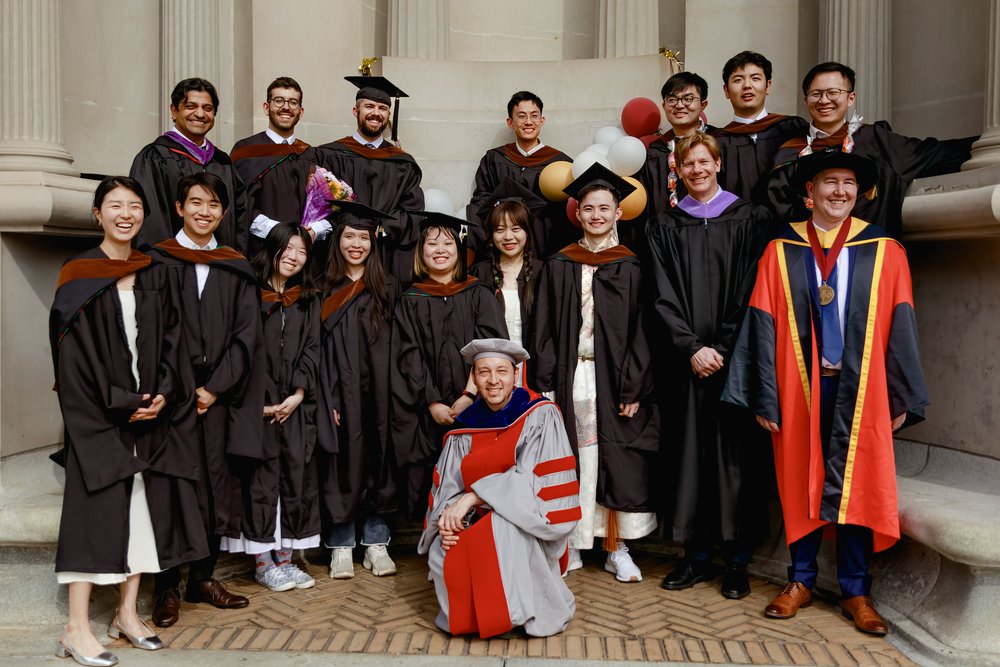e-SPAN Newsletter v027: Materiality: Aesthetics & Extractivism

The School of Architecture celebrated our graduates in a Diploma Ceremony on May 12, 2023.
Dear School of Architecture Community,
As we reach the end of the semester and celebrate the graduation of our Class of 2023, I want to reflect on some of the events of this past year.
Our public programs series set the year’s rhythm through the theme Materiality: Aesthetics and Extractivism. It fostered dialogue among invited speakers, faculty, students and alumni to explore the changing meanings of materiality in contemporary architecture. It also helped us reflect on how our pedagogical challenges—climate change, artificial intelligence and social justice—reframe our attitudes towards materiality.
While aesthetic and performative concerns remain paramount for architects’ material choices, environmental costs—including carbon emissions, toxic manufacturing and embodied energy—play a huge role in guiding these choices. Materials’ durational, poetic, and affective qualities emerged as strong themes in the lectures of Ensamble Studio, Xu Tiantian, Daniel Libeskind, Brandon Clifford and Catie Newell. And through new technological performances, we saw innovation in conventional materials like fabric and wood in the work of Felecia Davis and Leslie Lok, respectively.
We also considered materials’ profound costs through discussions of labor and its historic abuse in the design and construction professions. Natasha Iskander’s critique of the stadiums built for the World Cup in Qatar highlighted the extraction and exploitation of migratory labor across the world in massive construction projects; LaToya Ruby Frazier’s photographic work on Braddock, PA emphasized the ill effects of material toxicity on marginalized communities. These provided a necessary reframing of the work of architecture and its consequences for communities that are vital for its creation but in many cases are not its beneficiaries.
This discussion of materials informed the School’s teaching and research this year. I was heartened to see our Shop and dFAB Lab become sites of frenzied activity as students explored new materials and built physical models. Our NOMAS chapter, for example, constructed the innovative Carnival Gateway Pavilion out of bamboo partially sourced from the discards of a western Pennsylvania mining company. Our studios explored the complexity of materials’ engagement with technologies, cultural context, and oft-gendered construction culture. Current Thomas Visiting Professor Priyanka Bista ran Empathy, Architecture, and the Anthropocene, a study of interspecies coexistence in Nepal. Work from this studio will be featured at the Care Pavilion at the London Design Biennale this summer.

NOMAS students put finishing touches on the Carnival Gateway Pavilion.
This year we were thrilled to engage with alumni through visits to Boston in the fall and New York City in the spring (thank you to KPF for hosting a great event at their Midtown office!). It is wonderful for me to meet graduates from throughout the School’s history and to hear about their amazing work. I look forward to meeting more of you in San Francisco at next month’s AIA Conference, where School of Architecture alumni Andrea Love (B.Arch ‘02, now with Payette Associates) and Maureen Guttman (B.Arch ‘81, now with Energy Solutions) will be inducted into the College of Fellows. Congratulations on this honor!
We’re also happy to connect with alumni throughout the year via e-SPAN and look forward to profiling more of you next year. Please share the names of alumni we should highlight.
I’d like to close by congratulating our Class of 2023 graduates. It was such a pleasure to see them walk the stage and receive their diplomas. I was joined onstage by faculty and staff, Dean Mary Ellen Poole, and alum Carolyn Caranante (B.Arch ‘08, MSAECM ’09), who offered our commencement address. The following excerpt from my comments to the graduates recognizes our shortcomings but affirms our graduates’ capacity to address them with care and creativity:
Graduates, you are confronted with a world that offers many challenges and opportunities. I’m sorry that we and previous generations were not as “woke” as we needed to be. But you are, and you go out with a strong sense of purpose and justice. Be kind to the earth and the creatures that live on it with your designs and creations. Inform your clients and colleagues about the things you hold dear. Look to marginalized communities as your ethical compass, as they are the global majority that don’t have a seat at the table and are most affected by your decisions. And look to each other and the School as allies and supporters in how to change the values by which design and architecture will be measured in the future. I eagerly look forward to the world that your imaginations and skills will bring to reality.
I wish you all a wonderful summer. Please stay in touch.
Omar Khan
Head of School

Christine Mondor
(Special Faculty, FAIA, LEED AP)
Master of Urban Design (MUD) students in Christine Mondor’s Urban Ecology course took leadership in this semester’s Public Programs extractivism-inspired lecture series.
Here, she talks about how she integrated the lecture series with the course—and why both School of Architecture students and alumni should engage with the Public Programs as often as possible.

Why did you integrate the Public Programs lecture series into your Urban Ecology course?
As the Public Programs committee planned this year’s series, we wanted to ensure that it wasn’t simply lecture after lecture. So we created an ecosystem of different ways for students and faculty to be engaged. One of those was a class that parallels the conversation, where students could prepare to take leadership in engaging with the series.
How did you achieve that integration?
Students in the course grounded their understanding of the theme of extractivism in two seminal readings. The first, a chapter from Jane Hutton’s Reciprocal Landscapes, explores the complex reciprocal relationships between communities by describing the extraction of resources from the Pittsburgh region for use in New York’s Westside Waterfront park. The second, a chapter from William Cronon’s Changes in the Land, considers the drawing of boundaries and the conception of natural resources. He describes how the Native American tribes in New England considered their territory not as a bounded entity for sale, but a common set of resources for cultivation that could be borrowed by anyone for a period of time. Of course, when the English offered to “buy” the land, they imposed a boundary on the physical environment and considered all resources permanently acquired. These two texts—and our class conversations about students’ relevant experiences—set the stage for the lectures and gave them a ground from which to engage.
What would you tell alumni, or students who aren’t part of a course that’s explicitly engaged with the lecture series, about the Public Programs?
Attend as many as you can. This is easier said than done, since our students and alumni are so busy learning and building—but it’s about sowing seeds and allowing time for an expansion of thinking. In every lecture, something causes you to ask yourself, “What does this mean?” It may not be, “How can I use this right now?” but “what does this really mean? What can I connect it to?” If you try to connect the theme of a lecture with three other things—in your work, your life, another lecture—you’ll find a rich web, a new structure in your mind.

A group compares their initial thoughts about materiality and extraction at Framing the Discussion, the kick-off event of the semester, which took place on January 30. Students from Christine Mondor’s Urban Ecology seminar led the discussion.
MUD Students Reflect on Architecture, Urban Design, and Extractivism

Three Master of Urban Design students reflect on how their thinking about extractivism has changed this semester.
Having been exposed to architectural practice for five years, the public program series has had a profound impact on how I view the practice of architecture and urban design. The idea of extractivism has implications on a systemic scale. We are quick to diagnose the carbon emissions of the built environment, higher even than those of transportation and industry, through so-called sustainable materials. But in fact, the ways in which these materials are extracted from their source and brought to the site, or even the unethical labor practices involved, have made me question contemporary architectural practice.
The lecture series stressed the necessity for us as architects and urban designers to move past the Anthropocene and provide the conditions to foster relationships among communities and non-human species. How can we start to look at a symbiotic relationship among human, non-human and material ecologies? What does it mean for economic systems? How can we redefine paradigms that have been ingrained in our minds through capitalism?
- Koushik Srinath (MUD ‘24)
Before this semester, when connecting materiality to extractivism, I was only considering subtractive adjectives to define the built environment. Through the public programs, we studied various perspectives from practitioners as well as theoreticians. These helped me reconsider the ecological effects of architectural or infrastructural development, which are also additive in nature: we are leaving footprints in the environment with each endeavor. Those strata of history are important for us to assess our actions further down the road.
- Meghna Roy (MUD ‘24)
Prior to coming to Carnegie Mellon University, I was working in an architectural office where I would take pride in working on large-scale commercial projects and preferred wealthier clients with higher budgets for the best materials available on the market. At that point I never thought that my perspective towards this practice would change.
Through this spring’s lecture series, I learned about various "ism’s” (extractivism, capitalism, etc.) and processes of extracting material. This expanded my intellectual vocabulary and added a new lens of analysis. I am not an avid reader and the long readings assigned in class would often go over my head, but the public programs really engaged me. They were uncensored and unfiltered; one could grasp the emotions behind each lecture. I am not sure whether the experience has changed my inclination towards commercial architecture, but I am sure that it has made me sensitive towards a lot of things, which will be reflected in my professional work later.
- Yash Parikh (MUD ‘24)
Snapshots from the Spring Semester
NOMAS Carnival Pavilion
Students in the Carnival Entryway Pavilion Course, conducted by NOMAS and advised by instructor Vicky Achnani spent the semester designing, fabricating, constructing, and documenting the entryway structure for CMU’s Spring Carnival, which ran from April 13-16. This year, the entryway was constructed from salvaged bamboo. (Photos by Serena Sun)
Image

| Image

| Image

|
Image

| Image

| Image

|
Image

| Image

| Image

|
Carnival
The School of Architecture hosted a dedication of the NOMAS entryway pavilion and an open house for alumni and the CMU community at Spring Carnival on April 15.
Image

| Image

|
Spring 2023 Awards Ceremony
The Spring 2023 Awards Ceremony took place on April 17, where 29 undergraduate and graduate students were honored as award winners. The Spring Awards provide over $47,000 of funding support to undergraduate and graduate students, recognizing student work in public interest design, design and representation, sustainability, real estate, and professional promise. Following the ceremony, a reception presented by EPIC Metals was held in the College of Fine Arts Great Hall.
Image

|
Image

| Image

|
CMU Architecture Visits NYC
SoA Design/Build
The Design/Build Options Studio & Elective by professor Steve Lee is an ongoing, interdisciplinary design-build endeavor to improve the quality of life through design intervention(s) on campus.
The spring 2023 project was phase one of a major re-design to the Peace Garden including a rain garden, bioswale, black locust deck and benches, concrete tables and a sloped permeable surface for accessibility.
Image

| Image

| Image

|
The studio team included 2nd year, 4th year and 5th year B.Arch students and 2nd year M.Arch students. The elective team included BA, B.Arch, and CEE students.
Image

| Image

| Image

|
Alumni News & Updates
We invite all Carnegie Mellon Architecture alumni to keep us up to date on their awards, professional milestones and more. Send us your updates with a brief description and link to more information.











































































































